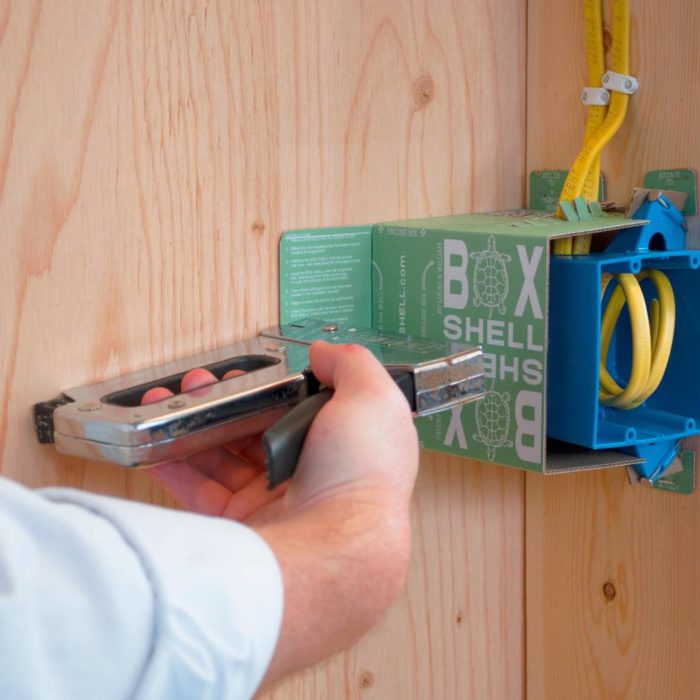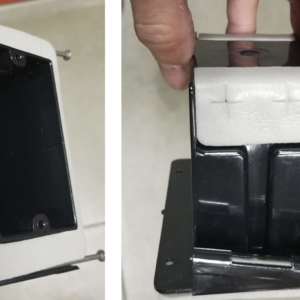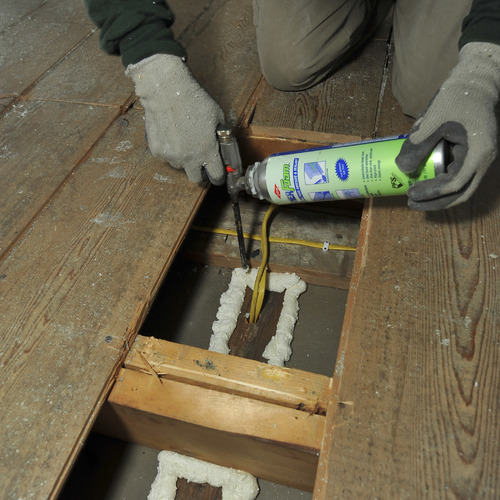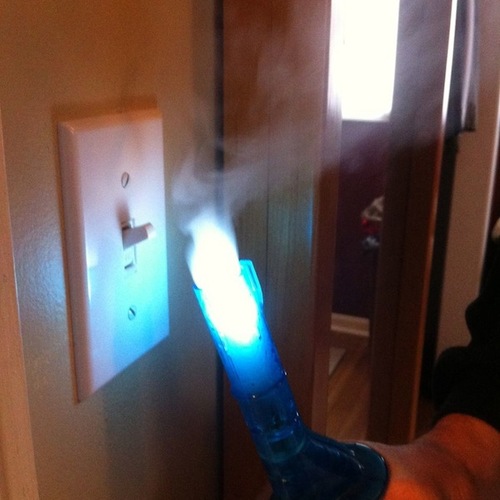Image Credit: Photos: Box Shell
Image Credit: Photos: Box Shell Once the drywall has been installed, the Box Shell can be filled with expanding latex foam. The foam seals the electrical box and insulates the space behind the box.
Two architects have come up with an inexpensive way of air-sealing and insulating electrical boxes in exterior walls.
After puzzling over the best way of meeting a code requirement for sealed boxes, Bill Hicks and Lucas Schad developed a cardboard form called the Box Shell that wraps around an electrical box. The form is slightly larger than the box, creating a small gap on the sides and a space at the back that is filled with expanding foam to air-seal and insulate.
The Box Shell is installed after wiring has been roughed in and before cavity insulation is placed in the wall. After drywall goes up, the installer inserts the nozzle of a can of expanding latex foam between the electrical box and the form and fills the gap around the box and the space behind it with foam. It’s the foam, not the box itself, that creates the seal.
The company offers the shells in three sizes — for single, double and triple junction boxes — all under $2 a pop.
Schad and Hicks both work for LTS Architecture, Schad in Livingston, Montana, and Hicks in Minnesota.
Brie Braukmann, Box Shell’s product manager, said the pair was looking for a way to comply with a provision of the 2012 International Energy Conservation Code requiring sealed electrical boxes in exterior walls. Although there are other products on the market for sealing boxes, they are either more difficult to install, more expensive, or don’t provide as effective a seal, Braukmann said.
The company is very young. Braukmann joined the group in May, and in mid July the company was still waiting for its first shipment of factory-made boxes after exhausting its small supply of samples, some of them made by hand (the shipment has since arrived, and Box Shell’s website lists all three sizes for sale).
Box Shell hasn’t spent much on advertising so far and instead has been relying on word-of-mouth and social media. But the reaction among builders so far has been positive, especially when they know what the energy code requires.
“They’ve been really intrigued,” Braukmann said.
Weekly Newsletter
Get building science and energy efficiency advice, plus special offers, in your inbox.
















14 Comments
A good start- needs improvement.
Ease of installation seems pretty good, but as-designed there is zero space between the electrical box for insulation. While air tightness is job 1, it would be a lot better if there were room for at least R3 fluff between the back of the box and the sheathing to limit the condensation/frost potential inside the switch box in cold climates.
Response to Dana Dorsett
Dana,
I think that the designers intend for the installer to push the nozzle of the spray foam can far enough back to fill the space between the back of the electrical box and the wall sheathing with canned spray foam.
While opportunities for screwing up exist -- I can imagine unseen voids -- I think that a conscientious installer could make sure that there is insulation behind the box.
Curing, verifiabilty
I'd want to try, or see someone else neutral try, making a half dozen or more mock-ups and cut them open afterwards to make sure it works consistently. Probably the people making this have done that but it's hard to have confidence that the foam would cure well where it's thick back there, and to have confidence that it's easy to consistently fill it well. When an operation requires doing it right, the installer usually gets feedback by seeing when it worked well and when it didn't. But the results of this seem to be hidden--it seems like you could do a hundred and not know which ones turned out well inside and which didn't. So it might be hard to get better at the process.
Martin- you're right (again? :-) )
Step 10 on their how-to guide:
https://www.jboxshell.com/pages/how-to-guide
"10. Using low expansion latex spray foam, push the nozzle tube between the junction box and the BOX SHELL. Push tube all the way to the back along the box. Slowly fill up the void between the junction box and the BOX SHELL with foam. Look inside the junction box during this process. When foam starts to come through the wire holes in the back of the box, pull the spray tube almost all the way out. Continue to fill slowly until a small amount of foam can be seen all the way around the wall material and the junction box. NO foam will be seen on the framing side of the junction box."
expanding latex foam
expanding LATEX foam ? Never heard of it.
Response to Robert Fankhauser
Robert,
Here is one of them: DAPtex Plus Multi-Purpose Foam Sealant.
For more information on latex spray foam, see Spray-Foam Sealant: Latex vs. polyurethane.
Bravo!
This product is just genius! Now if they can market it to the "big box" suppliers (maybe even a kit including the latex foam-in-a-can vs the stuff normally found) they have a true game changer!
Thank you and New Spray Foam Installation Video
Thank you all for your comments! It is humbling that you are writing about an invention that we were prototyping only months ago! Please check out our new product video where we show how to install spray foam in a triple Box Shell. You can see it on out Facebook page: http://www.facebook.com/boxshell/
Hopefully that explains the product installation a little better!
Thank you again for commenting! Please like us on Facebook for more updates! Please ask questions! Your input prompted us to create the latest video the way we did!
Has anyone had problems with inspector taking issue with the latex foam that get into the box? My town is using 2015 ICC codes, i don't see anything in the code for approved or unapproved sealant in electrical boxes but I may have missed it.
Matt,
Common sense usually applies here. It is indeed a code violation to fill an electrical box with insulation; the air in the box is necessary to help the electrical connections dissipate heat. The volume of air in the box is critical. But most inspectors won't fret about a tiny amount of caulk or expanded foam.
The person who is using expanding foam needs to be careful, to minimize the amount of foam that ends up inside the box.
I'm curious about how the foam is getting into the box. The tabs to secure the wire provide a pretty effective dam. Any small excess should be easy to knock off with a finger.
Matt,
The reason we suggest using low expansion latex foam is that it is very low expansion. Because of this, when you are filling the void behind the junction box and pull the tube out when foam hits the wire holes at the rear, you don't risk having the foam overflowing into the interior of it. When used with even a low expansion window and door foam, you will find the need to practice as it is easy to have blow-outs where you have the junction box filled and foam coming out around the edges at the dry wall. Plus the latex foam can be easily cleaned up with soap and water, so if you have all of the dry wall textured and painted before you foam the voids, its an easy cleanup.
Check out this video from our test runs.
https://www.facebook.com/boxshell/videos/865138586949638/
Bill
So, you shouldn’t use fireblock foam?. I notice they said low expansion foam - what about low expansion window and door foam even though that is normally polyurethane as I understand it.
Kevin, we have a patent pending on a new version that can be used in walls requiring fire protection to make it easier and faster than applying putty to the junction boxes. We hope to get through R&D this summer and have a UL listing if all goes right.
Bill from Box Shell
Log in or create an account to post a comment.
Sign up Log in